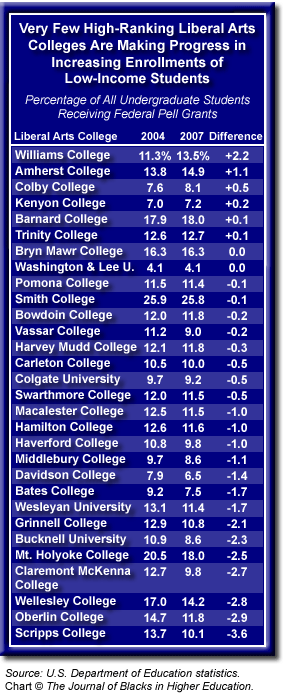



Most High-Ranking Liberal Arts Colleges Show a Decline in Low-Income Students
Last week JBHE reported that over the past three years 25 of the nation’s 30 highest-ranked universities had seen a drop in the percentage of their undergraduate students who come from low-income families. This occurred despite wide-ranging efforts by these universities to enrich their student financial aid programs so that low-income students could attend without incurring large debt.
Now we turn to the performance of the selective liberal arts colleges. Among this group Davidson College and Amherst College have led the way by eliminating all student loans and replacing them with scholarship grants. Most of the other leading liberal arts colleges have followed by making their financial aid packages more attractive to low-income students.
But data obtained by JBHE from the U.S. Department of Education on recipients of Pell Grants at these high-ranking liberal arts colleges shows that these educational institutions have not been successful in increasing the socioeconomic diversity of their student bodies. (Pell Grants are reserved for students who come from families with low incomes.) JBHE’s analysis shows that despite these new financial aid programs, only six of 30 leading liberal arts colleges have shown an increase in the percentage of low-income students. At Williams College, the percentage of the student body that comes from low-income families increased from 11.3 percent in 2004 to 13.5 percent in 2007. Amherst College also showed a good increase of 1.1 percentage points. Colby College, Kenyon College, Barnard College, and Trinity College all showed smaller gains. At Bryn Mawr College and Washington and Lee University, the percentage of low-income students remained the same during the period.
But at 22 of the 30 leading liberal arts colleges the percentage of students from low-income families has declined between 2004 and 2007. The largest drop was at Scripps College in California. There the percentage of low-income students dropped from 13.7 percent to 10.1 percent. Grinnell College, Bucknell University, Mount Holyoke College, Claremont McKenna College, Wellesley College, and Oberlin all saw a drop of more than two percentage points.

![]()
Copyright © 2008. The Journal of Blacks in Higher Education. All rights reserved.